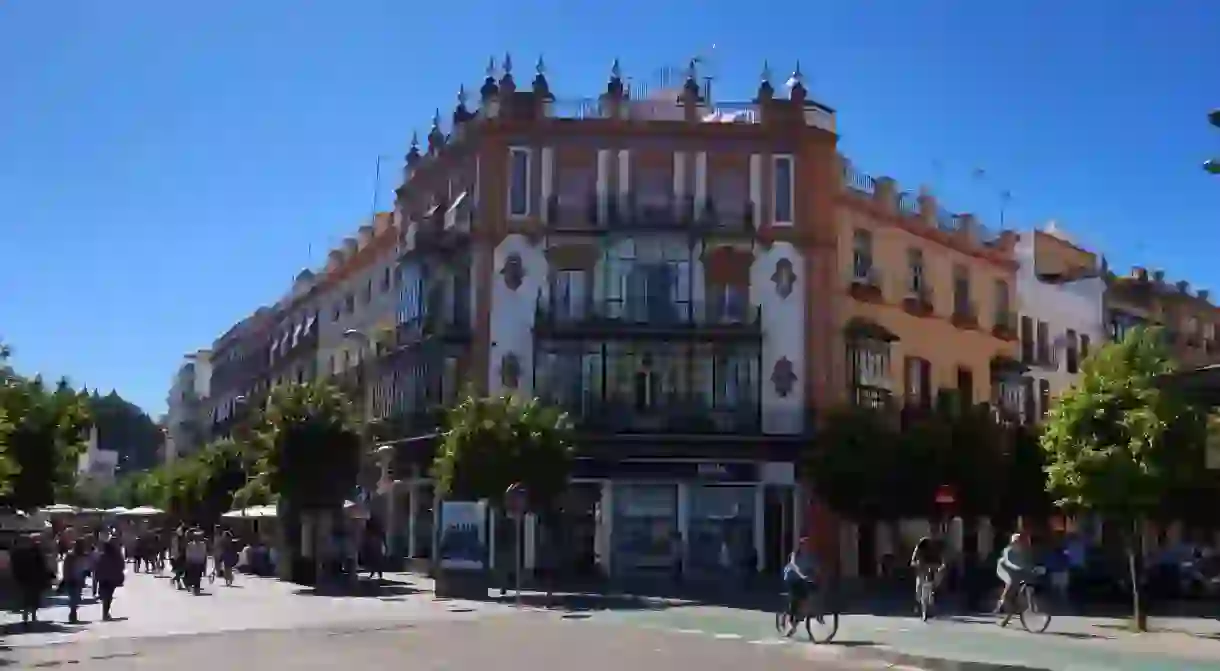How to Spend the Perfect Weekend in Seville

In a city as charming and lively as Seville, you’d have to try extremely hard not to have a wonderful weekend. Its colorful, romantic streets and squares, an endless supply of both modern and traditonal bars and restaurants and its historic attractions mean the Andalusian capital will not disappoint, no matter what your idea of a great 48 hours is.
After arrriving in a new city for the weekend, your starting point should give you a moreish appetizer; a tase of what you’re in for over the next couple of days. Few places offer a better microcosm of Seville life than the Mercado Lonja del Barranco, a stylish gourmet food market on the riverbank just down from Seville’s Plaza de Armas bus station. Seville has a reputation in Spain for being pijo, or “posh,” and its locals are referred to (sometimes with amused affection, sometimes with disparagement) as pijos – a stereotype which a couple of hours at this sophisticated cluster of food stalls and bars won’t disprove.

Expensively-clothed ladies of leisure sip daintily from glasses of white wine at the gleaming white bars, while men swagger about in the apparent uniform of blue blazers, crisp white shirts, jeans and mocassins. Lonja del Barranco is not only great for people watching, but offers a range of international cuisine as well as traditional Andlausian dishes prepared with verve and style. On warm days, of which there are a great many here, the rowdy socializing spills out onto smart terraces on the riverbank.
Mercado Lonja del Barranco, Calle Arjona, Sevilla, Spain,+34 954 220 495

After a leisurely introduction to Seville over lunch at Lonja del Barranco, head to the historic city center for a little culture. It’s about a 10 minute walk to the two key historic attractions. The Cathedral of Saint Mary of the See is the largest cathedral and third largest church in the world. Construction of this sprawling Gothic complex, which takes up the equivalent of several city blocks, began in 1401 and continued for over a hundred years. In 1507 the cathedral was finally completed, quite spectacularly succeeding in its original aim – namely, to show the rest of Europe how powerful and wealthy Seville had become.
Seville Cathedral, Av. de la Constitución, Seville, Spain, +34 902 099 692

All over Andalusia, displays of Catholic might sit alongside monuments from the region’s several hundred years under Muslim rule. Seville is no exception, with its Moorish Alcázar palace located just a few minutes on foot from the huge cathedral, and is well worth setting aside a couple of hours to visit properly. Though considered one of the finest examples of Moorish architecture in Spain, the Alcázar’s various sections in fact have differing styles and date from the Mudéjar and Renaissance periods as well as from the city’s Moorish epoch, which lasted from the 8th to the 13th centuries. And though it might lack the architectural pedigree of its more famous counterpart in Granada, the delicate interiors of Seville’s Moorish palace are every bit as fascinating.
Real Alcázar de Sevilla, Patio de Banderas, Seville, Spain, +34 954 502 324

After a long lunch and a little history, it will be time for a siesta, especially in the heat of spring and summer. After which, refreshed and ready to go again, weave your way through the animated early-evening crowds to the Alameda de Hércules. This expansive plaza was for many decades the domain of pickpockets, drug-dealers and prostitutes; its shabby, unloved surrounding streets were home to 35 brothels at one time. But owing to a costly facelift by Seville Council between 2006-2008, it is now the city’s most fashionable nightspot. The Alameda’s many spacious terraces make for perfect spots from which to watch the evening “paseo” (promenade) over drinks and dinner, after which you can simply cross over the square for decently-priced cocktails into the early hours, in a “pijo” late-night bar.

Sundays progress slowly and hedonistically in Seville, so the key to getting the most out of them is to not plan too much. For a leisurely morning, head to one of the city’s most attractive public spaces, the Plaza de España. Built in 1928 in preparation for Seville’s hosting of the Ibero-American fair of 1929, this vast, half-moon building showcases the blend of neo-Moorish and Renaissance Revival styles that is distinctive of many structures in Seville. Overlooking these beautiful buildings is a vast plaza surrounded by a moat, on which you can enjoy some gentle boating before lunch.

After which, dedicate the rest of the day to Triana. The traditional gypsy quarter of Seville – steeped in the closely-related arts of bullfighting and flamenco – sits prettily on the other side of the Guadalquivir river from the city’s main attractions. It is at its most lively at the weekends, particularly on a Sunday. At lunchtime, locals pour out of the churches in their finest “pijo” attire, colorful proof of the fact that you’re in a traditional Andalusian Catholic town as well as major tourist destination. Families joyfully collide in the street and fuss over babies in prams before crowding into the local tapas joints – the walls of which are plastered with old bullfighting posters, mounted bulls’ heads and weeping Virgin Marys – for lunches that go on all afternoon. There is no better way to pass a hot, lazy Sunday in Seville than to simply blend in among them and keep the tapas and cold beers coming.














